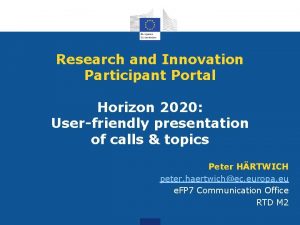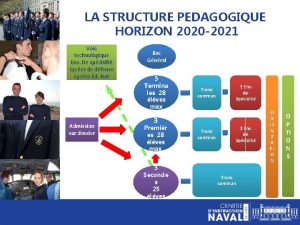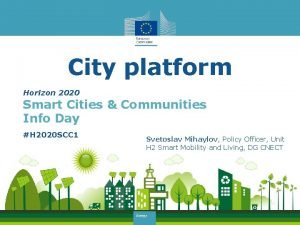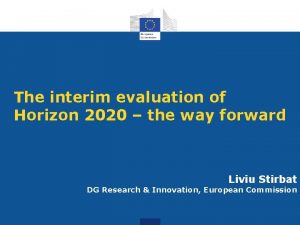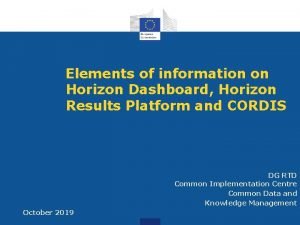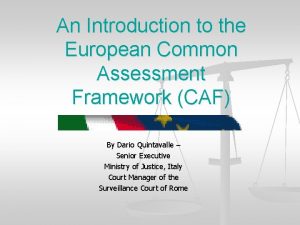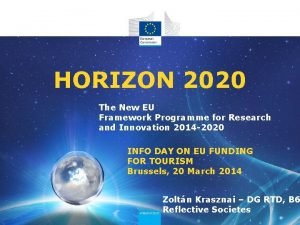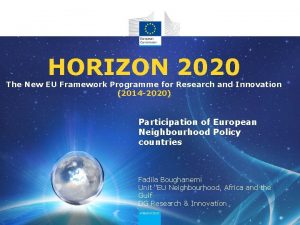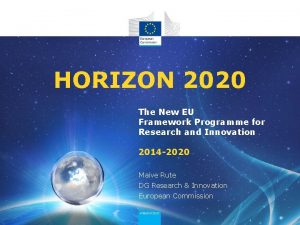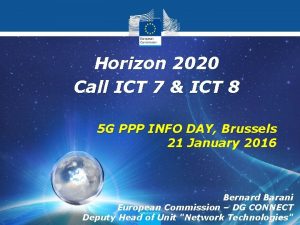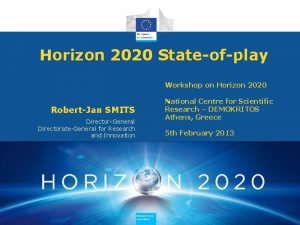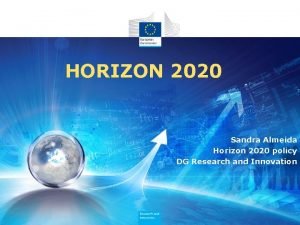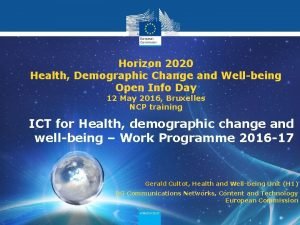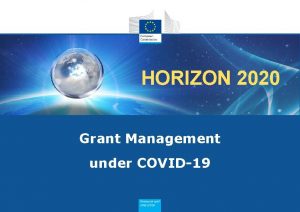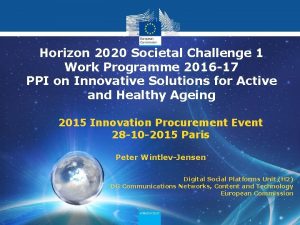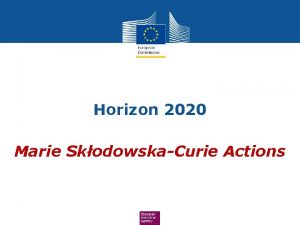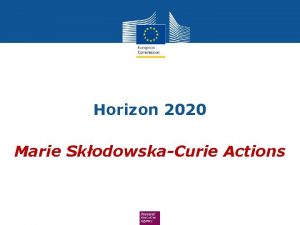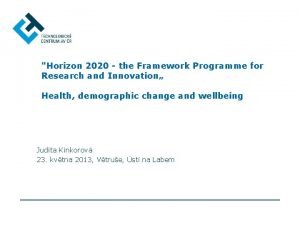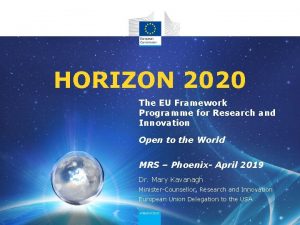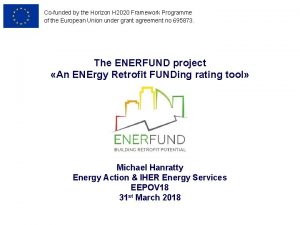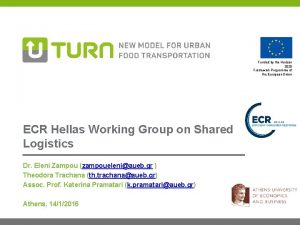HORIZON 2020 ICT The New EU Framework Programme























































- Slides: 55

HORIZON 2020: ICT The New EU Framework Programme for Research and Innovation 2014 -2020 Dr Aniyan VARGHESE European Commission DG CONNECT aniyan. varghese@ec. europa. eu

The Multiannual Financial Framework 2014 -2020: European Council conclusions, 8 February 2013 Key challenge: stabilise the financial and economic system while taking measures to create economic opportunities 1. Smart & inclusive growth (€ 451 billion) Education, Youth, Sport Connecting Europe Cohesion Competitive Business SMEs HORIZON 2020 2. Sustainable growth, natural resources (€ 373 billion) 3. Security and citizenship (€ 16 billion) 4. Global Europe (€ 58 billion) 5. Administration (€ 61. 6 billion) TOTAL € 960 billion

Investment in R&D is part of the solution to exit from the economic crises

What is Horizon 2020 • Initial Commission proposal for a € 80 billion research and innovation funding programme (2014 -2020); now just over € 70 billion • A core part of Europe 2020, Innovation Union & European Research Area: − Responding to the economic crisis to invest in future jobs and growth − Addressing people’s concerns about their livelihoods, safety and environment − Strengthening the EU’s global position in research, innovation and technology

What's new • A single programme bringing together three separate programmes/initiatives* • Coupling research to innovation – from research to retail, all forms of innovation • Focus on societal challenges facing EU society, e. g. health, clean energy and transport • Simplified access, for all companies, universities, institutes in all EU countries and beyond The 7 th Research Framework Programme (FP 7), innovation aspects of Competitiveness and Innovation Framework Programme (CIP), EU contribution to the European Institute of Innovation and Technology (EIT)

Coverage of the full innovation chain Societal challenges Industrial leadership Excellent science Basic Research Demonstration Technology R&D Prototyping Large scale validation Pilots Market uptake

Three priorities 31% 22% Excellent science Industrial leadership Societal challenges + EIT, JRC, Widening, Swf. S 8% 39%

Priority 1. Excellent science • Why: • World class science is the foundation of tomorrow’s technologies, jobs and wellbeing • Europe needs to develop, attract and retain research talent • Researchers need access to the best infrastructures

Proposed funding (€ million, 2014 -2020)* European Research Council (ERC) Frontier research by the best individual teams Future and Emerging Technologies Collaborative research to open new fields of innovation 13 095 2 696 Marie Skłodowska-Curie actions (MSCA) Opportunities for training and career development 6 162 Research infrastructures (including e-infrastructure) Ensuring access to world-class facilities 2 488 All funding figures in this presentation are subject to the pending Multiannual Financial Framework Regulation by the EP and the Council

Priority 2. Industrial leadership • Why: • Strategic investments in key technologies (e. g. advanced manufacturing, micro-electronics) underpin innovation across existing and emerging sectors • Europe needs to attract more private investment in research and innovation • Europe needs more innovative small and medium-sized enterprises (SMEs) to create growth and jobs

Proposed funding (€ million, 2014 -2020) Leadership in enabling and industrial technologies (LEITs) (ICT, nanotechnologies, materials, biotechnology, manufacturing, space) 13 557 Access to risk finance Leveraging private finance and venture capital for research and innovation Innovation in SMEs Fostering all forms of innovation in all types of SMEs 2 842 616 + complemented by expected 20% of budget of societal challenges + LEITs and 'Access to risk finance' with strong SME focus

Priority 3. Societal challenges • Why: • Concerns of citizens and society/EU policy objectives (climate, environment, energy, transport, etc) cannot be achieved without innovation • Breakthrough solutions come from multi-disciplinary collaborations, including social sciences & humanities • Promising solutions need to be tested, demonstrated and scaled up

Proposed funding (€ million, 2014 -2020) Health, demographic change and wellbeing 7 472 Food security, sustainable agriculture and forestry, marine and maritime and inland water research and the Bioeconomy 3 851 Secure, clean and efficient energy * 5 931 Smart, green and integrated transport 6 339 Climate action, environment, resource efficiency and raw materials 3 081 Inclusive, innovative and reflective societies 1 310 Secure societies 1 695 Science with and for society 462 Spreading excellence and widening participation 816 Additional funding for nuclear safety and security from the Euratom Treaty activities (2014 -2018)

Simplification: Rules for Participation 1. A single set of rules: ü Adapted for the whole research and innovation cycle ü Covering all research programmes and funding bodies ü Aligned to the Financial Regulation, coherent with other new EU Programmes 2. One project – one funding rate ü Maximum of 100% of the total eligible costs (except for innovation actions, where a 70% maximum will apply for profit making entities) ü Indirect eligible costs: a flat rate of 25% of direct eligible costs 3. Simple evaluation criteria ü Excellence – Impact – Implementation (Excellence only, for the ERC) 4. New forms of funding aimed at innovation ü pre-commercial procurement, inducement prizes, dedicated loan and equity instruments 5. International participation ü facilitated but better protecting EU interests

Simplification: Rules for Participation 6. Simpler rules for grants ü broader acceptance of participants accounting practices for direct costs, flat rate for indirect costs, no time-sheets for personnel working full time on a project, possibility of output-based grants 7. Fewer, better targeted controls and audits ü Lowest possible level of requirements for submission of audit certificates without undermining sound financial management ü Audit strategy focused on risk and fraud prevention 8. Improved rules on intellectual property ü Balance between legal security and flexibility ü Tailor-made IPR provisions for new forms of funding ü A new emphasis on open access to research publications Beyond the Rules: further simplified provisions in the Grant Agreement and implementing procedures to facilitate access to Horizon 2020 (e. g. common IT platform).

Simplification: summary • Single set of simpler and more coherent participation rules • New balance between trust and control • Moving from several funding rates for different beneficiaries and activities to just two • Replacing the four methods to calculate overhead or «indirect costs» with a single flat rate • Major simplification under the forthcoming financial regulation • Successful applicants to get working more quickly: time-to-grant of 8 months; exceptions for the ERC and in duly justified cases

Next steps • Formal political decisions on Horizon 2020 Autumn 2013 • Formal political decision on Multi-annual financial framework (2014 -2020) Autumn 2013 • Adoption of work programme and publication of first calls for proposals • Horizon 2020 national launch events 11 December 2013 October to January 2014

ICT in Horizon 2020

Europe 2020 priorities Shared objectives and principles ICT ICT ICT - Tackling Societal Challenges Health, demographic change and wellbeing Food security, sustainable agriculture and the bio-based economy Secure, clean and efficient energy Smart, green and integrated transport Climate action, resource efficiency and raw materials Inclusive, innovative and reflective societies Secure Societies EIT JRC Simplified access - Creating Industrial Leadership and Competitive Frameworks - Leadership in enabling and industrial technologies -ICT -Nanotech. , Materials, Manuf. and Processing -Biotechnology -Space - Access to risk finance - Innovation in SMEs Excellence in the Science Base Frontier research (ERC) Future and Emerging Technologies (FET) Skills and career development (Marie Curie) Research infrastructures ICT ICT Common rules, toolkit of funding schemes Dissemination & knowledge tranfer

Excellent Science - ICT • Future and Emerging Technologies (FET) • FET Open: fostering novel ideas • FET Proactive: nurturing emerging themes and communities • FET Flagships: pursuing grand interdisciplinary science and technology challenges • Research infrastructures • Developing the European research infrastructure for 2020 and beyond • Development, deployment and operation of ICTbased e-infrastructures

Future and Emerging Technologies (FET) / 2014 -2015 (overall budget 472 M€) • FET Open (160 M€) • All technologies, no topical scope • Light and fast scheme • Several cut-off dates per year, one-step submission of ~15 pages • One stage evaluation • FET Proactive • Global Systems Science (GSS) (10 M€) • Improve the way in which scientific knowledge can stimulate, guide, and help evaluate policy and societal responses to global challenges • Knowing, doing, being: cognition beyond problem solving (15 M€) • New approaches to cognitive systems • Quantum simulation (10 M€) • Quantum technologies to ultimately address real world problems • Towards exascale high performance computing (97, 4 M€) HPC PPP: To be coordinated with complementary work in LEIT and RI • FET Flagships (179, 6 M€) • Graphene • Human Brain Project ► Warning: still subject to Commission Decision

e. Infrastructures / 2014 -2015 (overall budget 177 M€) • ICT • • • infrastructure resources and services for Research (48 M€) Provision of core services across e-infrastructures Research and Education Networking – GEANT e. Infrastructures for virtual research environments • Access to and management of scientific data (72 M€) • Managing, preserving and computing with big research data • Towards global data e-infrastructures – Research Data Alliance • e. Infrastructure for Open Access • High Performance Computing (57 M€) • Pan-European High Performance Computing infrastructure and services • Centres of Excellence for computing applications • Network of HPC competence centres for SMEs ► Warning: still subject to Commission Decision

Industrial Leadership - ICT • A new generation of components and systems: • engineering of advanced embedded and resource efficient components and systems • Next generation computing: • advanced and secure computing systems and technologies, including cloud computing • Future Internet: • software, hardware, infrastructures, technologies and services • Content technologies and information management: • ICT for digital content, cultural and creative industries • Advanced interfaces and robots: • robotics and smart spaces • Micro- and nanoelectronics and photonics: • key enabling technologies

Components and systems / 2014 -2015 (overall budget 142 M€) • Covers systemic integration from smart integrated components to cyber-physical systems • Complementary to the JTI Electronic Components and Systems (ECSEL) • Organised in three related topics: • Smart cyber-physical systems (56 M€) • Next generation embedded and connected systems • Smart system integration (48 M€) • Integration of heterogeneous micro- and nanotechnologies into smart systems • Advanced Thin, Organic and Large Area Electronics (38 M€) • R&I in this area will also contribute to the implementation of the SRA on Energy Efficient Buildings ► Warning: still subject to Commission Decision

Advanced Computing / 2014 -2015 (overall budget 57 M€) • Reinforce and expand Europe's industrial and technology strengths in low-power ICT • Focus is on integration of advanced components on all levels in computing systems • Complementary to and coordinated with work in the Future Internet area (on Cloud Computing) and in Excellence Science pillar under Research Infrastructures and FET (on High Performance Computing) • Organised in one topic: • Customised and low power computing ► Warning: still subject to Commission Decision

Future Internet / 2014 -2015 (overall budget 395, 5 M€) • Focused on network and computing infrastructures to accelerate innovation and address the most critical technical and use aspects of the Internet • Organised in ten topics: • Smart networks and novel Internet architectures (24 M€) • Smart optical and wireless network technologies (30 M€) • Advanced 5 G Network Infrastructure for the Future Internet (125 M€) 5 G PPP • Advanced cloud infrastructures and services (73 M€) • Boosting public sector productivity and innovation through cloud computing services (22 M€) • Tools and methods for Software Development (25 M€) • FIRE+ (Future Internet Research & Experimentation) (31, 5 M€) • More Experimentation for the Future Internet (18 M€) • Collective Awareness Platforms for sustainability and social innovation (37 M€) • Web Entrepreneurship (10 M€) ► Warning: still subject to Commission Decision

Content technologies and information management / 2014 -2015 (overall budget 260 M€) • Addresses: - Big Data with focus on both innovative data products and services and solving research problems - Machine translation in order to overcome barriers to multilingual online communication - Tools for creative, media and learning industries in order to mobilise the innovation potential of SMEs active in the area - Multimodal and natural computer interaction • Organised in eight topics: • Big data and Open Data innovation and take-up (50 M€) • Big data research (39 M€) • Cracking the language barrier (15 M€) • Support to the growth of ICT innovative creative industries SMEs (15 M€) • Technologies for creative industries, social media and convergence (41 M€) • Technologies for better human learning and teaching (52 M€) • Advanced digital gaming/gamification technologies (17 M€) • Multimodal and natural computer interaction (31 M€) ► Warning: still subject to Commission Decision

Robotics / 2014 -2015 (overall budget 157 M€) • Roadmap-based research driven by application needs Robotics PPP • Effort to close the innovation gap to allow large scale deployment of robots and foster market take-up: use-cases, pre-commercial procurement, industry-academia cross-fertilisation • Includes two pre-commercial procurement actions (health-care sector, public safety and environmental monitoring) • Additional activities: shared resources, performance evaluation & benchmarking, community building and robotic competitions • Organised in two annual calls (of 74 M€ and 83 M€ respectively) ► Warning: still subject to Commission Decision

Micro- and nano-electronics and photonics Key Enabling Technologies / 2014 -2015 (overall budget 206 M€) • Covers generic technology developments on micro- and nanoelectronics focused on advanced research and lower Technology Readiness Levels (TRLs) (50 M€) • Complementary to the JTI Electronic Components and Systems • Addresses the full innovation and value chain in markets sectors where the European photonics industry is particularly strong (optical communications, lighting, medical photonics, laser technologies, etc. ) (156 M€) Photonics PPP • Includes calls for ERANETs as well as public procurement actions (roll-out and deployment of optical networking technologies) ► Warning: still subject to Commission Decision

Factory of the Future / 2014 -2015 (overall budget 102 M€) • Focuses on ICT components of innovative production systems in all sectors (for more personalised, diversified and mass-produced product portfolio and for rapid adaptations to market changes) • Organised in three topics: • Process optimisation of manufacturing assets (34 M€) • ICT-enabled modelling, simulation, analytics and forecasting technologies (32 M€) • ICT Innovation for Manufacturing SMEs (36 M€) • Part of Fo. F PPP ► Warning: still subject to Commission Decision

ICT Cross-Cutting Activities / 2014 -2015 • Internet of Things and platforms for Connected Smart Objects (51 M€) • Cutting across several LEIT-ICT areas (smart systems integration, smart networks, big data) • Bringing together different generic ICT technologies and their stakeholder constituencies • Human-centric Digital Age (7 M€) • Understanding technologies, networks and new digital and social media and how these are changing the way people behave, think, interact and socialise as persons, citizens, workers and consumers • Cyber-security, Trustworthy ICT (38 M€) • Focuses on security-by-design for end to end security and a specific activity on cryptography • Complementary to Cyber-security in Societal Challenge 7 • Trans-national co-operation among National Contact Points (4 M€) • Mechanisms for effective cross border partnership searches, identifying, understanding and sharing good practices among ICT NCPs ► Warning: still subject to Commission Decision

ICT horizontal innovation actions / 2014 -2015 • Support for access to finance (15 M€) • Pilot action for business angels to co-invest in ICT innovative companies • Implemented by EIF and closely coordinated with "Access to risk finance" part of H 2020 • Innovation and Entrepreneurship Support (11 M€) • • ICT business idea contests in universities and high schools ICT entrepreneurship summer academy ICT entrepreneurship labs Campaign on entrepreneurship culture in innovative ICT sectors Support for definition and implementation of inducement prizes European networks of procurers Pre-commercial procurement • Open Disruptive Innovation Scheme (90 M€) • Support to a large set of early stage high risk innovative SMEs in ICT • Implementation through the SME instrument -> Continuously open calls with several (3) cut-off dates/year -> 5% of LEIT budget ► Warning : still subject to Commission Decision

International cooperation actions / 2014 -2015 (overall budget 27 M€) • Coordinated calls • EU-Brazil (7 M€) • Cloud computing, including security aspects • High performance computing • Experimental platforms • EU-Japan (6 M€) • Technologies combining big data, internet of things in the cloud • Optical communications • Acces networks for densely located users • Experimentation and development on federated Japan-EU testbeds • International partnership building and support to dialogues with high income countries (USA, Canada, East Asia and Oceania) (3 M€) • International partnership building in low and middle income countries (11 M€) ► Warning: still subject to Commission Decision

Societal Challenges - ICT • Health, demographic change and wellbeing • Food security, sustainable agriculture, and forestry, marine, maritime and inland water research, and the bioeconomy • Secure, clean and efficient energy • Smart, green and integrated transport • Climate action, environment, resource efficiency and raw materials • Europe in a changing world – inclusive, innovative and reflective societies • Secure societies – protecting freedom and security of Europe and its citizens

Key principles for ICT R&I in the Societal Challenges • Interoperability • Re-use and economies of scale • Breakthroughs leveraging the transformative power of ICT • Preparation for market deployment + • Information for future digital policy

Proposed funding (€ million, 2014 -2015) Challenge Health, demographic change and wellbeing Food security, sustainable agriculture, marine and maritime research & the Bioeconomy Total ICT % 1 804 269 15% 687 Secure, clean and efficient energy 1 447 72 5% Smart, green and integrated transport 1 542 92 6% Climate action, resource efficiency and raw materials 745 26 3, 5% Innovative, inclusive and reflective societies 310 82 26% Secure societies 393 100 25%

Health, demographic change and wellbeing / 2014 -2015 (overall budget 269) • Advancing active and healthy ageing with ICT • Service robotics within assisted living environments • ICT solutions for independent living with cognitive impairments • ICT solutions enabling early risk detection and intervention • Integrated, sustainable, citizen-centred care • ICT-based approaches for integrated care (beyond current state-of-art in tele-health and tele-care) • Self-management of health and disease • Public-procurement of innovative e. Health services • Improving health information and data exploitation • Digital representation of health data to improve diagnosis and treatment • e. Health interoperability ► Warning: still subject to Commission Decision

Secure, clean and efficient energy / 2014 -2015 (overall budget 72 M€) • Energy efficiency / buildings and consumers • Public procurement of green data centres • New ICT-based solutions for energy efficiency through citizens' behavioural change • Competitive low-carbon energy / modernising the single European electricity grid • Distribution grid and retail market • Next generation ICT infrastructure for smart metering and smart grids • Smart cities and communities • Integration of energy, transport and ICT through lighthouse projects (large scale demonstration) ► Warning: still subject to Commission Decision

Smart, green and integrated transport / 2014 -2015 (overall budget 92 M€) • Road • Cooperative Intelligent Transport Systems • Connecting people, vehicles, infrastructures and businesses • Safe and connected automation in road transport • Green vehicles • Electric vehicles' enhanced performance and integration into the transport system and the electricity grid • Smart cities and communities • Integration of energy, transport and ICT through lighthouse projects (large scale demonstration) ► Warning: still subject to Commission Decision

Climate action, environment, resource efficiency and raw materials / 2014 -2015 (overall budget 26 M€) • Waste management • ICT solutions for waste traceability, waste material flow management • Water management • Development and deployment of advanced ICT solutions for water resources management in agriculture and urban areas ► Warning: still subject to Commission Decision

Europe in a changing world – inclusive, innovative and reflective societies / 2014 -2015 (overall budget 82 M€) • Reflective societies – Cultural Heritage • Innovative ecosystems of digital cultural assets • Advanced 3 D modelling for accessing and understanding European cultural assets • New forms of innovation • Innovation in the public sector by using emerging ICT technologies • ICT-enabled open government • • Personalised public services M-government Open participation Transparency • ICT for learning and inclusion ► Warning: still subject to Commission Decision

Secure societies – protecting freedom and security of Europe and its citizens / 2014 -2015 (overall budget 100 M€) • Digital security: cybersecurity, privacy and trust • Protecting our society by providing sustained trust in the usage of ICT and in securing the ICT underlying our digital society • Preventing cyber-attacks on any component of the digital society • Ensuring freedom and privacy in the digital society, protecting the fundamental values of our society and democratic rights of our citizens in cyberspace • Protect the weak in our society from abuses over the internet and giving the user control over his private data • Demonstrating the viability and maturity of state-of-the-art security solutions in large scale demonstrators, involving end users ► Warning: still subject to Commission Decision

Guide to the presence of ICT in H 2020 • Comprehensive coverage of all three H 2020 pillars • Detailed list of calls and topics • Detailed budget allocation and call deadlines not provided yet

Call planning overview (indicative) • LEIT • H 2020 -ICT-2014 (ICT Call 1) • • • Publication date: 11 December 2013 Deadline: 23 April 2014 (all topics except 5 G Future Internet) Deadline for 5 G Future Internet: 25 November 2014 • H 2020 -Fo. F-2014/2015 (Factory of the Future) • • Publication date: 11 December 2013 Deadlines: 20 March 2014 and 9 December 2014 • H 2020 -EUJ-2014 (EU-Japan Call) • • Publication date: 7 January 2014 Deadline: 10 April 2014 • H 2020 -ICT-2015 (ICT Call 2) • • Publication date: 15 October 2014 Deadline: 14 April 2015 • H 2020 -EUB-2015 (EU-Brazil Call) • • Publication date: 15 October 2014 Deadline: 21 April 2015

HORIZON 2020 Thank you for your attention! Find out more: www. ec. europa/research/horizon 2020

Additional slides on H 2020

Horizon 2020 and partnering Public private partnerships: • Through Joint Technology Initiatives or other formal structures (Art. 187) • Through contractual agreements, which provide inputs for work programmes • Only when criteria met, e. g. clear commitments from private partners Public partnerships: • Through « ERA-Nets » for topping up individual calls/actions (replacing current ERA-Net, ERA-Net Plus, Inco-Net, Inno-net) • Through participation in joint programmes between Member States (Art. 185) • Supporting agendas of Joint Programming Initiatives when in line with Horizon 2020 • Only when criteria met, e. g. financial commitments of participating countries European Innovation Partnerships: • Not funding instruments, but for coordination with broader policies and programmes

Innovation Investment Package € 22 billion Innovation Investment Package Joint Technology Initiatives (under Article 187) • • • Innovative Medicines Initiative 2 Clean Sky (Aeronautics) 2 Fuel Cell and Hydrogen 2 Bio-based Industries Electronic components and systems Joint programmes (under Article 185) • European and Developing Countries Clinical Trials Partnership (EDCTP) 2 • European Metrology Research Programme 2 • Eurostars (for SMEs) 2 • Active and Assisted Living 2

Benefits of Partnerships Joint Technology Initiatives (with industry) • • • Industry driven research agenda Fixed budget for 7 years to leverage more industry investment Sector structuring to achieve impact Coverage of longer value chains and interrelated sectors Higher level of SME participation (30%) than in FP 7 Links and synergies with Structural and Investment Funds Joint programmes (with Member States) • • Link to national programmes Leverage effect Industry involvement Cross-border collaboration

Role of the EIT and JRC in Horizon 2020 Proposed funding (€ million, 2014 -2020) European Institute of Innovation & Technology (EIT) Combining research, innovation & training in knowledge and Innovation Communities Joint Research Centre (JRC)* Providing a robust, evidence base for EU policies Additional funding for the JRC for Euratom Treaty activities 2 711 1 903

Contributing to the European Research Area (ERA) • ERA framework proposal in 2012 to create a single market for knowledge research and innovation • Complemented by Horizon 2020: ü Boosting support to ERA priorities – mobility, infrastructures, knowledge transfer, policy learning ü Stronger partnerships with Member States and private sector to invest more efficiently ü Taking account of gender, ethical issues, researcher careers and open access to results

Strong participation by SMEs • Integrated approach - around 20% of the total budget for societal challenges and LEITs to go to SMEs • Simplification of particular benefit to SMEs (e. g. single entry point) • A new SME instrument will be used across all societal challenges as well as for the LEITs • A dedicated activity for research-intensive SMEs in 'Innovation in SMEs' • 'Access to risk finance' will have a strong SME focus (debt and equity facility)

Socio-economic sciences and humanities (SSH) • Integrated approach: SSH included as an integral part of the activities, working beyond 'silos' (e. g. understanding the determinants of health and optimising the effectiveness of healthcare systems) • The 'Inclusive and reflective societies' challenge: issues such as smart and sustainable growth, social transformations, social innovation and creativity, the position of Europe as a global actor as well as the social dimension of a secure society (SSH have the tools to contribute to addressing security challenges, enhancing the societal dimension of security policy and research) • Bottom-up funding: ERC, MSCA, Research Infrastructures

Widening participation • Principle of excellence: continue to allocate funding on the basis of competitive calls, selecting only the best projects • Clear division of labour between cohesion policy and Horizon 2020 ü Cohesion policy: support for regions in building up their research and innovation capacity ü Horizon 2020: widen participation, better coordination between the two Union funding programmes, support policy learning reforms • Accompanying measures in Horizon 2020 to ensure that excellence prevails wherever it exists, including: twinning, ERA chairs, support for access to international networks, development of smart specialisation strategies

International cooperation • International cooperation is crucial to address many Horizon 2020 objectives • Principle of general openness: the programme will remain to be the most open funding programme in the world • Horizon 2020 shall be open to the association of: acceding countries, candidate countries and potential candidates and selected international partner countries that fulfil the relevant criteria (capacity, track record, close economic and geographical links to the Union, etc. ) • Targeted actions to be implemented taking a strategic approach to international cooperation (dedicated measures in the 'Inclusive, innovative and secure societies' challenge)
 Horizon 2020 portal
Horizon 2020 portal Horizon 2020 2021
Horizon 2020 2021 Horizon 2020 smart cities
Horizon 2020 smart cities Horizon 2020
Horizon 2020 Horizon 2020 dashboard
Horizon 2020 dashboard Three horizons framework
Three horizons framework New horizon english book 4
New horizon english book 4 English book unit 1
English book unit 1 Revised programme of assessment 2020
Revised programme of assessment 2020 2020 revised curriculum and assessment plans
2020 revised curriculum and assessment plans Revised programme of assessment 2020
Revised programme of assessment 2020 Ems programme of assessment
Ems programme of assessment Hsc.lc
Hsc.lc Common assessment framework 2020
Common assessment framework 2020 Dispositional framework vs regulatory framework
Dispositional framework vs regulatory framework Conceptual framework explanation example
Conceptual framework explanation example Franmework
Franmework Conceptual framework theoretical framework
Conceptual framework theoretical framework Dispositional framework vs regulatory framework
Dispositional framework vs regulatory framework Conceptual framework vs theoretical framework
Conceptual framework vs theoretical framework Hình ảnh bộ gõ cơ thể búng tay
Hình ảnh bộ gõ cơ thể búng tay Lp html
Lp html Bổ thể
Bổ thể Tỉ lệ cơ thể trẻ em
Tỉ lệ cơ thể trẻ em Gấu đi như thế nào
Gấu đi như thế nào Chụp phim tư thế worms-breton
Chụp phim tư thế worms-breton Chúa yêu trần thế alleluia
Chúa yêu trần thế alleluia Các môn thể thao bắt đầu bằng tiếng bóng
Các môn thể thao bắt đầu bằng tiếng bóng Thế nào là hệ số cao nhất
Thế nào là hệ số cao nhất Các châu lục và đại dương trên thế giới
Các châu lục và đại dương trên thế giới Cong thức tính động năng
Cong thức tính động năng Trời xanh đây là của chúng ta thể thơ
Trời xanh đây là của chúng ta thể thơ Cách giải mật thư tọa độ
Cách giải mật thư tọa độ Phép trừ bù
Phép trừ bù Phản ứng thế ankan
Phản ứng thế ankan Các châu lục và đại dương trên thế giới
Các châu lục và đại dương trên thế giới Thể thơ truyền thống
Thể thơ truyền thống Quá trình desamine hóa có thể tạo ra
Quá trình desamine hóa có thể tạo ra Một số thể thơ truyền thống
Một số thể thơ truyền thống Cái miệng xinh xinh thế chỉ nói điều hay thôi
Cái miệng xinh xinh thế chỉ nói điều hay thôi Vẽ hình chiếu vuông góc của vật thể sau
Vẽ hình chiếu vuông góc của vật thể sau Nguyên nhân của sự mỏi cơ sinh 8
Nguyên nhân của sự mỏi cơ sinh 8 đặc điểm cơ thể của người tối cổ
đặc điểm cơ thể của người tối cổ Ví dụ giọng cùng tên
Ví dụ giọng cùng tên Vẽ hình chiếu đứng bằng cạnh của vật thể
Vẽ hình chiếu đứng bằng cạnh của vật thể Vẽ hình chiếu vuông góc của vật thể sau
Vẽ hình chiếu vuông góc của vật thể sau Thẻ vin
Thẻ vin đại từ thay thế
đại từ thay thế điện thế nghỉ
điện thế nghỉ Tư thế ngồi viết
Tư thế ngồi viết Diễn thế sinh thái là
Diễn thế sinh thái là Các loại đột biến cấu trúc nhiễm sắc thể
Các loại đột biến cấu trúc nhiễm sắc thể Các số nguyên tố là gì
Các số nguyên tố là gì Tư thế ngồi viết
Tư thế ngồi viết Lời thề hippocrates
Lời thề hippocrates Thiếu nhi thế giới liên hoan
Thiếu nhi thế giới liên hoan
